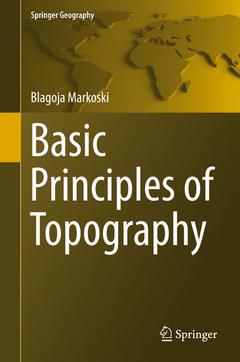Description
Basic Principles of Topography, 1st ed. 2018
Springer Geography Series
Author: Markoski Blagoja
Language: English
Subjects for Basic Principles of Topography:
Keywords
Morphometric Elements of Terrain; Genetic and Topographic Types of Terrain; Representation of Terrain on Maps; Thematic Cartography; Cartographic Projection; Methods for Orientation in Geographic Space; GPS; Elements of Maps and Topographic Signs; Geographic Names and Labels; Topography textbook; landscape/regional and urban planning
Publication date: 04-2019
219 p. · 15.5x23.5 cm · Paperback
Publication date: 02-2018
219 p. · 15.5x23.5 cm · Hardback
Description
/li>Contents
/li>Biography
/li>Comment
/li>
This book gives a comprehensive overview of all relevant elements in topography and their practical application. It elaborates on the classical representation of terrain on maps such as cartographic projections, together with their classification, scale, and geographical elements. It is richly illustrated with photographs, maps and figures, in which the theoretical explanations are clarified.
Readers will become acquainted with the physical characteristics of the ground, i.e. tectonic and erosive shapes, the importance and classification of terrain, genetic (fluvial, abrasive, glacial, karst) and topographic types such as higher (mountains, hills, peaks) and lower terrain (valleys, fields). In addition, the book discusses cartometry and coordinate systems, orientation in space (geographic, topographic, tactical) including by means of maps, instruments and the night sky and elaborates new techniques and technologies such as aerial photogrammetric imagery, global navigation satellite systems and LiDAR.
The book also includes methods for the practical execution of concrete measurement operations, such as determining position and movement on land with maps, compass and azimuth which makes it especially useful for practitioners and professionals, e.g., for landscape planning, military exercises, mountaineering, nature walks etc. As such it offers a valuable guide not only for undergraduate students but also for researchers in the fields of geography, geosciences, geodesy, ecology, forestry and related areas looking for an overview on topography. Uniquely, the book also features an extensive glossary of topographical terms.
He has published more than 147 articles in various national and international journals and another 40 papers in proceedings of symposiums and congresses. On scientific events he has presented over 45 scientific papers. He has published four monographs and 53 thematic maps.
Prof. Markoski is author of three college textbooks and has authorized three scripts, one High School textbook and three textbooks for Elementary Schools.
So far, he has participated over 20 research projects, of which on eight as leading party and head of the project.
He has visited several institutes abroad in Melbourne, Belgrade, Sofia, Ljubljana, Paris and Budapest. As an expert in geographic names from Macedonia, on several occasions he participated in the work of the bodies for geographical names in the United Nations in Geneva, New York and Budapest.He is currently the President of the Macedonian Geographical Society (since 2007), Chairman of the Council on Statistics of the Republic of Macedonia (since 2007 and President of the University Sports Federation of Macedonia (since 2006),
He held several positions at the Faculty of Natural Sciences and Mathematics of the University of Skopje. He was President of the Council of the Faculty (1998/1999), Vice Dean for Finances (1999/
Features an extensive glossary of topographical terms
Offers a comprehensive overview of classical topography for geographers, geoscientists, geodesists, ecologists, and foresters
Provides exercises and recommendations for further reading on the various topics discussed
Constitutes a useful tool for terrestrial navigation and for practitioners (e.g., landscape planning, mountaineering, military exercises)




